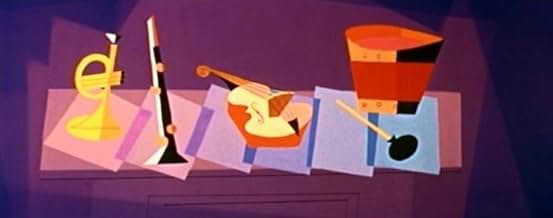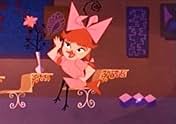VALUTAZIONE IMDb
7,1/10
1624
LA TUA VALUTAZIONE
Aggiungi una trama nella tua linguaA crash course on the history of Western musical instruments.A crash course on the history of Western musical instruments.A crash course on the history of Western musical instruments.
- Regia
- Sceneggiatura
- Star
- Vincitore di 1 Oscar
- 2 vittorie totali
The Mellowmen Quartet
- Singing Group
- (voce)
- (non citato nei titoli originali)
Loulie Jean Norman
- Penelope Pinfeather
- (voce)
- (non citato nei titoli originali)
Charlie Parlota
- Chorus Singer
- (voce)
- (non citato nei titoli originali)
Bill Thompson
- Professor Owl
- (voce)
- (non citato nei titoli originali)
- …
Gloria Wood
- Suzy Sparrow
- (voce)
- (non citato nei titoli originali)
Recensioni in evidenza
If you think that Disney animators were only good at drawing cutesy animals in the 1950's then you need to see this film. The animation style is like nothing you've ever seen in a Disney film. While it does have its share of cute animals (the setting is a classroom full of birds), many of the characters are strange, geometric looking creations. I especially enjoyed the ancient Egyptian characters modeled after ancient Egyptian art. This is an educational short on the origins of music, but also works as a great comedy. The "Plunk" section is the best! It's a one joke bit, but it never gets old.
It's the professorial owl who is teaching his class all about musical instruments. It's manna from heaven for an animator as the entertainingly crafted lyrical narration (complete with slightly annoying singing) takes us all on a very basic lesson in musical onomatopoeia! It was the cavemen who started, rather monotonically, with a dead cow's horn. Next, for the Egyptians it's a different kind of "King Toot" who wants something altogether more sophisticated. Trumpets, dear reader. What happens when trumpets get beaten up; the curvy bits and varying lengths give it flexibility and huzzah, the horn was born. You've got the drift by now and as the other three principal sections of the orchestra: woodwind, strings (quite excruciatingly at times) and finally percussion get an the treatment this leads us to the synchronised, and thankfully more tuneful, modern orchestra. It's a bit too long, this, but it is still quite good fun as they even manage to squeeze the bagpipes in there. The singing doesn't get any better, though - sorry.
We join Professor Owl as he teaches his avian students about where all the music comes from - in other words, the whole TOOT WHISTLE PLUNK AND BOOM of the matter.
This very engaging cartoon gives a lighthearted look at the origin of musical instruments. Using humor as the best tool to teach - in this instance zany cavemen bang home the lessons - it leaves the viewer with several pertinent facts from the fascinating world of musical history.
TOOT WHISTLE PLUNK AND BOOM was the Disney Studio's first foray into stylized, or limited, animation. The result was very successful & the 1953 Oscar for best cartoon was the reward.
This very engaging cartoon gives a lighthearted look at the origin of musical instruments. Using humor as the best tool to teach - in this instance zany cavemen bang home the lessons - it leaves the viewer with several pertinent facts from the fascinating world of musical history.
TOOT WHISTLE PLUNK AND BOOM was the Disney Studio's first foray into stylized, or limited, animation. The result was very successful & the 1953 Oscar for best cartoon was the reward.
10llltdesq
This short, Disney's best in some time, won an Oscar and clearly shows an influence from the animation style of the UPA studios that were doing remarkable work in the 1950s. Disney did a number of shorts that were different stylistically and in tone than the work they had produced in the 1930s and 1940s and this is probably the best of those shorts. I's good to see that it's available, even if it's only on a DVD as additional material. Most recommended.
As I said above, I really wanted to hate this film...but I couldn't. The reason I wanted to give this film a savage review is that it represents a style of animation that I hate--the very modern and minimalistic animation that came into vogue in the 1950s and lasted through the 70s. Up until films like TOOT WHISTLE PLUNK AND BOOK and films by (uggh) UPA Studios, animation had been very detailed and higher quality. Gorgeous backgrounds and high frame-rates were the norm in the 40s and into the 50s with studios like Looney Tunes, MGM and Disney. But, with the success of very simplistic UPA films like Gerald McBoing-Boing and Mr. Magoo (beating out traditional films for Oscars AND costing a fraction to make), Disney decided to experiment with this splashier but tremendously easy style of animation. So, for the style of this film and what it represented, I wanted to hate the film.
The problem is that although I disliked the art, I couldn't help but like the film--even though it was quite educational. In fact, now that I finished the film, I am still amazed because I usually watch animation to have fun--not learn things! But, I found that I enjoyed the learning.
The film is about the basic parts of music and how all instruments fall within four broad categories--those that go 'toot', those that whistle, those that are plucked ('plunk') and those that are struck ('boom'). This may seem silly, but it really did make sense and made me understand and appreciate music a lot more. In particular, I learned why horns are all curvy and how a trumpet works--and that's really cool.
Overall, a great film to teach anyone (not just kids) about the fundamentals of music AND it does it in a way that isn't boring. Who would have thought this was possible?!
The problem is that although I disliked the art, I couldn't help but like the film--even though it was quite educational. In fact, now that I finished the film, I am still amazed because I usually watch animation to have fun--not learn things! But, I found that I enjoyed the learning.
The film is about the basic parts of music and how all instruments fall within four broad categories--those that go 'toot', those that whistle, those that are plucked ('plunk') and those that are struck ('boom'). This may seem silly, but it really did make sense and made me understand and appreciate music a lot more. In particular, I learned why horns are all curvy and how a trumpet works--and that's really cool.
Overall, a great film to teach anyone (not just kids) about the fundamentals of music AND it does it in a way that isn't boring. Who would have thought this was possible?!
Lo sapevi?
- QuizThis was the first animated cartoon in CinemaScope.
- Citazioni
Owl: Today we're going to study about...
Boy bird: [looking at a comic book] Ancient history?
Susy Sparrow: Love and mystery?
Penelope Pinfeather: [writing on the blackboard] Mathematics?
Twin brothers: [balancing other students on their heads] Acrobatics?
Students: Readin', spellin'...
Bertie Birdbrain: Storytellin'?
Owl: No, no, no!
[bops Bertie on the head]
Owl: The study of musical instruments is the subject for today.
The Canary Sisters: [singing] The study of musical instruments is the subject for today!
- Versioni alternativeBlack stereotypes have been cut from this short on the DVD version.
- Colonne sonoreA Toot And A Whistle And A Plunk And A Boom
Written by Sonny Burke & Jack Elliott
I più visti
Accedi per valutare e creare un elenco di titoli salvati per ottenere consigli personalizzati
Dettagli
- Data di uscita
- Paese di origine
- Lingua
- Celebre anche come
- Toot Whistle Plunk and Boom
- Aziende produttrici
- Vedi altri crediti dell’azienda su IMDbPro
- Tempo di esecuzione10 minuti
- Proporzioni
- 2.35 : 1
Contribuisci a questa pagina
Suggerisci una modifica o aggiungi i contenuti mancanti

Divario superiore
By what name was Tà-tà Tì-tì Zin-zin Bum! (1953) officially released in Canada in English?
Rispondi


















